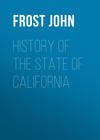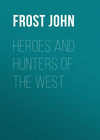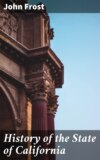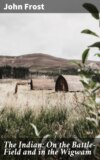Kitabı oku: «History of the State of California»
PREFACE
The occupation of California by the people of the United States, and the discovery of its rich gold mines, form a new era in the history of the world. According to present appearances, these events forebode a complete revolution in monetary and commercial affairs. The receipts of gold from California have already produced a sensible effect on the financial affairs of our country; and far-seeing people predict an entirely new state of things with respect to the relative value of money and property.
Still more important effects are anticipated from the establishment of a new, rich, and enterprising State of the American Union on the shores of the Pacific. Railroads across the continent will soon transport the rich products of Eastern Asia, by a quick transit, to the Atlantic cities and to Europe; and a passage to China or India, which was formerly a serious undertaking, will become a pleasant excursion.
To gratify the public curiosity with respect to the history and present state of this new member of the Union, is the purpose of this volume. In preparing it, the author has passed rapidly over the early history, and dwelt chiefly on recent events, and the actual state of the country, as he considered that, by this course, utility would be more effectually consulted.
In the Appendix he has introduced the constitution of California, and some official documents, whose importance demanded their preservation in a permanent form.
CHAPTER I
GEOGRAPHICAL OUTLINE OF CALIFORNIA
The territory called California is that part of North America situated on the Pacific Ocean, and extending from the 42° of north latitude southwardly to 22° 48', and from 107° longitude, west from Greenwich, to 124°. It is bounded on the north by Oregon territory, east by territories belonging to the United States and the Gulf of California, and on the south and west by Mexico and the Pacific Ocean. California is naturally divided into two portions; the peninsula, called Lower California, and the territory extending northward from the peninsula, on the Pacific Ocean, called Upper California. The line of division between Upper and Lower California runs nearly along the 32d parallel of latitude, westward from the head of the Gulf of California.
The peninsula of California is about one hundred and thirty miles in breadth, where it joins the continent. It extends south-eastwardly, generally diminishing in breadth, till it terminates in two points. The point farthest south-west is called Cape San Lucas. The other, sixty miles east by north of San Lucas, is called Cape Palmo. The peninsula is about seven hundred miles long.
Upper California extends, upon the Pacific, from the 32d parallel of latitude, northward to the 42d parallel, a distance of about seven hundred miles. It is separated from Oregon by a range of highlands, called the Snowy Mountains, or, by the Spaniards, the Sierra Nevada. The eastern limit of Upper California is rather uncertain. By some it is considered as including the region watered by the Colorado River, while others limit it by the great mountain range that extends along the western side of the continent.
The Californian peninsula seems to be a prolongation of the great western chain of mountains. It consists entirely of high, stony ridges, separated by sandy valleys, and contains very few tracts of level ground. In a general view, it might be termed an irreclaimable desert. The scarcity of rain and the small number of springs of water, with the intense heat of the sun's rays, uninterrupted in their passage, render the surface of the country almost destitute of vegetation. Yet in the small oases formed by the passage of a rivulet through a sandy defile, where irrigation is possible, the ground may be made to produce all the fruits of tropical climes, of the finest quality, and in great quantity. The southern portion of the peninsula contains several gold mines, which have been worked, though not to any great extent. On the Pacific side, the coast offers many excellent harbors, but the lack of fresh water near them proves an obstacle in the way of their occupation. The principal harbors are the Bay of la Magdalena, separated from the ocean by the long island of Santa Margarita, the Bay of Sebastian Vizcaino, east of the Isle of Cedaro, Port San Bartolomé, sometimes called Turtle Bay, and Port San Quintin, a good harbor, with fresh water in the vicinity, and called by the Spanish navigators the Port of the Eleven Thousand Virgins.
The great westernmost range of mountains runs northward from the peninsula, nearly parallel with the Pacific coast, to the 34th parallel of latitude, below which is Mount San Bernardin, one of the highest peaks in California, about forty miles from the ocean. Farther northward, the space between the mountains and the coast becomes wider, and, in a few places, reaches eighty miles. The intermediate region is traversed by lines of hills, or smaller mountains joined with the great range. The most considerable of the inferior ridges extends from Mount San Bernardin to the south side of the entrance of the Bay of San Francisco, where it is called the San Bruno Mountains. Between this range and the coast runs the Santa Barbara range, terminating at the Cape of Pines, on the south-west side of the Bay of Monterey. Bordering on the Bay of San Francisco, on the east side, is the Bolbona ridge. Beyond these are lines of highlands which stretch from the great chain and terminate in capes on the Pacific.
There are many streams among the valleys of Upper California, some of which, in the rainy season, swell to a considerable size. But no river, except the Sacramento, falling into the Bay of San Francisco, is known to flow through the maritime range of mountains, from the interior to the Pacific. The valleys thus watered offer abundant pasturage for cattle.
The principal harbors of Upper California are those offered by the Bays of San Francisco, Monterey, San Pedro, Santa Barbara, and San Diego. The Bay of San Francisco is one of the finest harbors in the world. The combined fleets of all the naval powers of Europe might there find safe shelter. It is surrounded by ranges of high hills, and joins the Pacific by a passage two miles wide and three in length. The other harbors can only be frequented in the fine season, and afford a very insecure shelter for vessels. San Diego is the farthest south. The bay at that place runs ten miles eastward into the land, and is separated from the ocean by a ridge of sand. Proceeding northward, about seventy miles, the Bay of San Pedro is next met. It is open to the south-west winds, but sheltered from the north-west. About a hundred miles north-west of San Pedro, is the harbor of Santa Barbara. It is an open roadstead sheltered from the north and west winds, but exposed to the violence of the south-westerly storms, which prevail during the greater part of the year. A hundred miles farther north is the Bay of Monterey. It is extensive, and lies in an indentation of the coast, somewhat semicircular. The southernmost portion is separated from the ocean by the point of land ending at the Cape of Pines. In the cove thus formed, stands the town of Monterey, for some time the capital of California. The harbor affords but a poor shelter from storms.
The Sacramento and San Joachim are the principal rivers of California, but the Sacramento alone is navigable to any extent worthy of mention. There are numerous small streams and lakes in the interior, the principal outlet of which is the Colorado River. The valleys through which these streams flow are fertile, and afford good pasture for cattle; but the remainder of the region between the maritime and the Colorado ranges of mountains is a barren waste of sand.
CHAPTER II
DISCOVERY OF CALIFORNIA
The first exploration of the Pacific coasts of North America was made by the Spaniards, in the sixteenth century. After Hernando Cortes had completed the conquest of Mexico, he commenced exploring the adjoining seas and countries; no doubt, with the hope of discovering lands richer than those which he had conquered, and which would afford new fields for the exercise of his daring enterprise and undaunted perseverance. He employed vessels in surveying the coasts of the Mexican Gulf, and of the Atlantic more northerly. Vessels were built upon the Pacific coast for like purposes, two of which as early as 1526, were sent to the East Indies.
The first expedition of the Spaniards, sent along the western coast of Mexico, was conducted by Pedro Nunez de Maldonado, an officer under Cortes. He sailed from the mouth of the Zacatula River, in July, 1528, and was six months engaged in surveying the shores from his starting-place to the mouth of the Santiago River, a hundred leagues farther north-west. The territory he visited was then called Xalisco, and inhabited by fierce tribes of men who had never been conquered by the Mexicans. Flattering accounts of the fertility of the country and of the abundance of the precious metals in it were brought back by the expedition, and these served to excite the attention of the Spaniards. When the expedition returned Cortes was in Spain, whither he had gone to have his title and powers more clearly defined. He returned in 1530 with full power to make discoveries and conquests upon the western coast of Mexico. From the opposition of his enemies, he was prevented from fitting out an expedition before 1532. The most northern post upon the Pacific coast, occupied by the Spaniards, was Aguatlan, beyond which the coast was little known.
The expedition sent by Cortes to the north-western coast of Mexico was commanded by his kinsman, Diego Hurtado de Mendoza. It sailed from Tehuantepec in July, 1532, and consisted of two vessels; one commanded by Diego Hurtado de Mendoza in person, and the other by Juan de Mazuela. Mendoza proceeded slowly along the shore of the continent as far as the 27° of latitude, where, his crew being mutinous, he sent back one of his vessels with the greater part of his men, and continued the voyage with the remaining vessel. Vague reports were afterwards received that Mendoza's vessel was thrown ashore somewhere to the northward, and that all on board had perished. The vessel which was sent back, was stranded near the mouth of the River Vanderas, and after the murder of the greater part of the crew, she was plundered by Nuno de Guzman, Governor of Xalisco. About the middle of the next year, Cortes received the news of the return of the vessel which Mendoza had sent back, and he immediately despatched two ships under the command of Hernando Grijalva and Diego Becerra, in search of the other. These ships sailed on the 30th of September, 1533, but were soon separated. Grijalva discovered the islands of St. Thomas, as he called them – a group of islands about fifty leagues from the coast. He remained there till the following spring, and then returned home. Becerra proceeded north-westward; but his crew mutinied, and he was murdered by Fortuno Ximenes. The mutineers, under Ximenes, then steered directly west from the main land, and soon reached a coast not known to them before. They landed, and soon after Ximenes and nineteen men were killed by the natives. The rest of the men carried the vessel over to Xalisco, where she was seized by Nuno de Guzman.
Soon after these unlucky expeditions, Nuno de Guzman sent out several exploring parties in a northerly direction, one of which traced the western shore as far as the mouth of the Colorado, and brought back accounts of a rich and populous country and splendid cities in the interior. When Cortes became acquainted with the seizure of his vessels, a dispute arose between him and Nuno de Guzman, which almost led to a battle between their forces. But no action occurred, and Cortes, having heard of the newly discovered country, which was said to abound in the finest pearls, embarked at Chiametla, with a portion of his men, and set sail for the new land of promise. On the 3d of May, 1535, the day of the Invention of the Holy Cross, according to the Roman Catholic Calendar, Cortes arrived in the bay where Ximenes and his fellow-mutineers had met their fate in the previous year. In honor of the day, the place was called Santa Cruz, and possession of it was taken in the name of the Spanish sovereign.
The country claimed by Cortes for Spain, was the south-east portion of the peninsula, which was afterwards called California. The bay, called by Cortes, Santa Cruz, was, perhaps, the same now known as Port La Paz, about a hundred miles from the Pacific, near the 24th parallel of latitude. Cortes landed on the shore of this bay, rocky and forbidding as it appeared, with a hundred and thirty men, and forty horses. He then sent back two of his ships to Chiametla, to bring over the rest of his troops. The vessels soon returned with a portion of the troops, and being again despatched to the Mexican coast, only one of them returned. The other was wrecked on her way. Cortes then took seventy men and embarked for Xalisco, from which he returned just in time to save his troops from death by famine. A year was spent in these operations, and the troops began to grow discontented. A few pearls had been found on the coast, but the country was found to be barren, and without attractions for Spaniards.
In the mean time, the wife of Cortes hearing reports of his ill success, sent a vessel to Santa Cruz, and entreated him to return. He then learned that he had been superseded in the government of New Spain by Don Antonio de Mendoza, who had already entered the capital as viceroy. Cortes returned to Mexico, and soon after, recalled the vessels and troops from Santa Cruz.
The viceroy, Mendoza, had received some information concerning the country north-west of Mexico, from de Cabeza-Vaca and two other Spaniards, who had wandered nine years, through forests and deserts, from Tampa Bay, Florida, until they reached Culiacan. They had received from the natives, accounts of rich and populous countries situated to the north-west. Mendoza, wishing to ascertain the truth of the reports, sent two friars, according to the advice of Las Casas, to make an exploration. They were accompanied by a Moor who had crossed the continent with Cabeza-Vaca and his friends, and they set out from Culiacan on the 7th of March, 1539.
Soon after the departure of the friars, Cortes sent out his last expedition. It was commanded by Francisco de Ulloa, and consisted of three vessels, well equipped. Sailing from Acapulco, on the 8th of July 1539, Ulloa reached the Bay of Santa Cruz, after losing one of his vessels in a storm. From Santa Cruz he started to survey the coast towards the north-west. He completely examined both shores of the Gulf of California, and discovered the fact of the connection of the peninsula with the main land, near the 32° of latitude. This gulf Ulloa named the Sea of Cortes. On the 18th of October, he returned to Santa Cruz, and on the 29th again sailed with the object of exploring the coasts farther west. He rounded the point now called Cape San Lucas, the southern extremity of California, and sailed along the coast towards the north. The Spaniards proceeded slowly, as they were opposed by north-western storms, and often landed and fought with the natives. In January, 1540, Ulloa reached the island under the 28th parallel of latitude, near the coast, which they named the Isle of Cedars. There he remained till April, when one of the ships, bearing the sick and accounts of the discoveries, was sent back to Mexico. The returning vessel was seized at Santiago by the officers of the viceroy. The fate of the remaining vessel is uncertain. Some of the writers of that day asserting that he continued his voyage as far north as the 30° of latitude, and returned safely to Mexico; while one asserts that nothing more was heard of him after the return of the vessel he sent back.
In the mean time, the two friars and the Moor penetrated a considerable distance into the interior of the continent, and sent home glowing accounts of rich and delightful countries which they said they had discovered. The inhabitants had, at first, been hostile, and had killed the Moor; but in the end submitted to the authority of the King of Spain. Mendoza, believing the accounts of the friars to be strictly true, prepared an expedition for the conquest of the countries they described. Disputes with the different Spanish chieftains occupied some months, at the end of which Cortes returned to Spain, in disgust. Mendoza despatched two bodies of troops, one by land, the other by sea, to reconnoitre the newly discovered land, and clear the way for conquest. The marine expedition was undertaken by two ships, under the command of Fernando de Alarcon, who sailed from Santiago on the 9th of May, 1540, and proceeding north-west along the coast, he reached the head of the California Gulf, in August of the same year. There he discovered the river now called the Colorado. The stream was ascended to the distance of eighty leagues, by Alarcon and some of his men, in boats; but all their inquiries were unsatisfactorily answered, and it was determined to return to Mexico. The vessels returned safely before the end of the year.
The land forces sent, at the same time, to the north-west, were composed of infantry and cavalry, and commanded by Francisco Vasquez de Coronado, who had been appointed governor of New Gallicia, in place of Nuno de Guzman. The party left Culiacan on the 22d of April, 1540, and took their way north, following the course described by the friars. They found the route which had been represented as easy, almost impassable. They made their way over mountains, and deserts, and rivers, and, in July, they reached the country called Cibola by the natives, but found it a half cultivated region, thinly inhabited by a people destitute of the wealth and civilization they had been represented as possessing. What had been represented as seven great cities, were seven small towns, rudely built. A few turquoises and some gold and silver supposed to be good, constituted the amount of what had been termed immense quantities of jewels, gold and silver. The Spaniards took possession of the country and wanted to remain and settle there. But Vasquez refused to acquiesce; and after naming one of the towns he visited, Granada, he started for the north-west, in search of other countries. The region called Cibola by the inhabitants, which Vasquez visited, is the territory now called Sonora, and is situated about the head waters of the Rivers Yaqui and Gila, east of the upper portion of the Gulf of California. The movements of the Spaniards after leaving Cibola, in August, 1540, have been the subject of very vague and contradictory accounts. All that is certain is, that the greater part of the force soon returned to Mexico, and that Vasquez, with the remainder, wandered through the interior for nearly two years longer, when, being disappointed in his expectations, he returned to Mexico in 1542.
In the spring of 1542, two vessels were placed under the command of Juan Roderiguez Cabrillo, a Portuguese navigator of great reputation. The two vessels sailed from Navidad, a small port in Xalisco, in June, 1542. They rounded Cape San Lucas, and proceeded north-west, along the coast, as far as the 88th degree of latitude, when he was driven back, and took refuge in a harbor of one of the San Barbara islands. There Cabrillo died and the command devolved on Bartolome Ferrelo. Ferrelo was a zealous and determined man, and he resolved to proceed with the expedition. He sailed towards the north, and on the 26th of February, reached a promontory near the 41st parallel of latitude, which he named Stormy Cape. On the 1st of March, the ships reached the 44th parallel, but they were again driven south; and the men being almost worn out, Ferrelo resolved to go back to Mexico. He arrived at Navidad on the 14th of April, 1543. The promontory called Stormy Cape by Ferrelo, was the most northern portion of California visited by that navigator, and it is probably the same which is now called Cape Mendocino.
From all accounts that they had been able to collect, the Spaniards concluded that neither rich and populous countries existed beneath the 40th parallel of latitude, nor was there any navigable passage between the Atlantic and Pacific Oceans to be found in the same region. They, therefore, ceased to explore the north-western territory for some time after the return of Ferrelo in 1543.
Having thus given a somewhat detailed account of the discovery and explorations of the territory now called California, it will be sufficient to merely mention the various expeditions that visited it prior to the first regular settlement. In the spring of 1579, California was visited by Sir Francis Drake, the English navigator, who landed on the shores of a bay supposed to be that of San Francisco. He formally took possession of the country in the name of Queen Elizabeth, and called it New Albion. He left California on the 22d of July, 1579. In the spring of 1596, Sebastian Viscaino, under orders from the viceroy of Mexico, attempted to plant colonies on the peninsula of California, but the country was soon abandoned on account of the barrenness of the soil and the ferocity of the natives. Viscaino visited the coast of Upper California in 1602, and discovered and named some of the places Cabrillo had discovered and named long before. The Port San Miguel of Cabrillo was named Port San Diego; Cape Galera was named Cape Conception, the name now borne by it; the Port of Pines was named Port Monterey. This was the last expedition made by the Spaniards along the coast of California for more than a hundred and sixty years.
Various attempts were made to establish colonies, garrisons, and fishing or trading ports, on the eastern side of the peninsula of California, during the seventeenth century, but all failed, either from the want of funds, the sterility of the country, or the hostility of the natives. The pearl fishery in the gulf was the principal bait that attracted the Spaniards, and they succeeded in obtaining a considerable quantity, some of which were very valuable.














